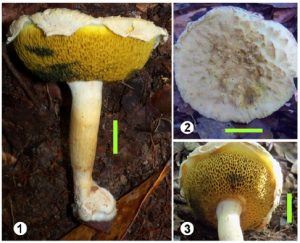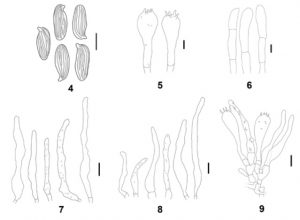Boletellus cremeovelosus Barbosa-Silva & Wartchow, sp. nov.; Index Fungorum number: IF823691
Etymology: From Latin ‘cremeus’ (cream) and ‘velosus’ (veil). Regarding to cream colored velar remnants on pileus.
Diagnosis: Boletellus cremeovelosus differs from all other taxa of section Boletellus in the complete lack of pink, red, lavender or purple tints on the basidiome and the fluffy/soft squamules pileus, on which they are more or less pyramidal/erect at centre then turning more flattened towards the margin.
BASIDIOME medium size, solitary or in cluster with very young. PILEUS ranging to 70 mm diameter, plane slightly depressed, pale beige (darker than OAC 813) with shade of cream (OAC 857); surface squamose with more or less fluffy/ soft pyramidal/erect at centre turning more flattened toward margin, with beige (OAC 777) or sometime brownish (OAC 776) tips; margin entire and strongly appendiculate projecting about 3 mm, thick, soft; context 12 mm thick near centre, pale then immediately changing to dark greenish blue (OAC 159) after sectioned, lemon yellow (OAC 896) then slowly darkening in KOH. HYMENOFORE tubulose, free, greenish (OAC 848) then olive (OAC 832 or 838) quickly changing to dark bluish green (OAC 194) when injured; tubes ranging to 6 mm long, mostly hexagonal 1–2 (–3) mm in diam., more elongate nearest the stipe; dark reddish brown (OAC 705) in KOH. STIPE: 88 × 20 mm, tapering downward to near bulb, uniformly cream (OAC 857) with brownish pots (OAC 770) some hours after handling, surface longitudinally fibrillose; context fleshy, solid, cream (OAC 815), unchanging with handling but turning lemon yellow (896) with KOH. ODOR and TASTE not performed.
BASIDIOSPORES (15.1–)15.8–20.4(–20.9) × (6.1–)6.6–9.2(–9.7) μm, L = 18.5 ± 1.37 μm, W = 7.7 ± 0.92 μm, Q = (1.91–)1.96–3.11(–3.25), Qm = 2.44 ± 0.28, subfusoid, inamyloid, pale meleous in KOH, thin-walled, longitudinally ribbed sometimes dichotomously forked, converging at poles, usually adaxially ventricose; sometimes with one or two large guttules. BASIDIA 43–50 × 12–17 μm, clavate, hyaline to pale in KOH, 4-occasionally 3-sterigmate; sterigmata short up to 2 μm long. SUBHYMENIUM mostly with interwoven short hyphae 3.5–7 μm, hyaline in KOH, sometimes appearing subcellular. PLEUROCYSTIDIA 45.4–93 × 5.1–12 μm, ventricose-lageniform, subventricose-lageniform to sublageniform, mostly narrow with a long neck mostly >50 μm long, pale yellowish to almost colorless in KOH, thin-walled, sometimes with oil-drop, scattered. CHEILOCYSTIDIA 34.5–97 × 4–11.5 μm, similar to pleurocystidia in shape, colorless in KOH, thin-walled, sometimes with oil-drop, abundant at tube edge. HYMENOPHORAL TRAMA boletoid, i.e. divergent, central stratum up to 20 μm wide with hyphae 3.5–8 μm wide, that slightly diverging ranging to 13 μm wide. PILEIPELLIS trichodermial, multiseptate cylindrical elements mostly suberect, pale yellow in KOH, terminal cells 9.5–14 μm wide, cylindrical, clavate to broadly clavate, oleiferous hyphae frequent 4–14 μm wide; pileal appendiculate edge with terminal elements similar to those of the rest of pileipellis; oleiferous hyphae also found, but less frequent. PILEUS TRAMA strongly interwoven, hyphae 3.5–16 μm wide, hyaline in KOH; oleiferous hyphae very common 4–11 μm wide. STIPITIPELLIS trichodermial palisade, multiseptate cylindrical elements, hyaline to faint slightly yellowish in KOH, terminal cells cylindrical, clavate to cylindric-clavate, 5–16 μm wide. STIPE TRAMA hyphae longitudinally oriented, interwoven, 4–14 μm wide, hyaline in KOH; oleiferous hyphae 3–14 μm wide, common. CLAMP CONNECTIONS absent.
HABITAT : Solitary or clustered together a very young basidiomes on base of living trunk of Coccoloba sp. from Atlantic Forest fragment of Pernambuco. Melo et al. (2011) referred to 10 species of this genus in the region: C. almifolia Casar., C. confusa R.A. Roward, C. declinata (Vell.) Mart. C. leavis Casar., C. lucidula Benth., C. marginata Benth., C. mollis Casar., C. ochreolata Wedd., C. parimensis Benth. and C. striata Benth.
Material examined – Brazil, Pernambuco, Igarassu, Usina São José, Mata da Cruzinha, 28 May 2010, F. Wartchow 23/2010 (JPB 63210 holotypus hic designatus).
Notes: Boletellus cremeovelosus, due its dry squamose pileus with appendiculate margin and basidiospores >16 μm long longitudinally ribbed is placed in the sect. Boletellus (Singer 1986, Halling et al. 2015). Among taxa of this group, Halling et al. (2015) used successfully the features of the scales on pileus surface for species concept. Following this concept, our new species is well characterized by the complete lack of pink, red, lavender or purple tints on the basidiome and the fluffy/soft squamules pileus, on which they are more or less pyramidal/erect at centre then turning more flattened toward margin.
FIGURE. Boletellus cremeovelosus (holotype). 1 Basidiome in side view. 2 Pileus surface. 3 Hymenophore. – Bars = 20 mm.

FIGURE. Boletellus cremeovelosus (holotype). 4 Basidiospores. 5 Basidia. 6 Terminal elements of pileipellis. 7 Pleurocystidia. 8 Cheilocystidia. 9 Basidia, pleurocystidia and subhymenium. – Bars = 10 μm.

